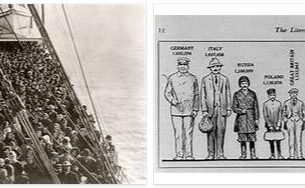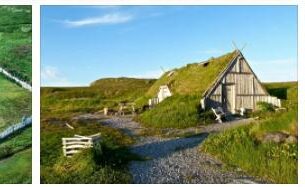With the Rocky Mountains begins the western section of the United States. It is a very complex system, the result of multiple corrugations in a very unstable area of the North American continental mass. Of these repeated orogenetic processes, the most ancient dating back to the Paleozoic, particularly powerful were those, called laramic, of the late Cretaceous (Mesozoic), which were accompanied by intense volcanic activity: the Yellowstone National Park, between the Absaroka and Teton mountains, offers a stunning “sample” of volcanic manifestations among which the geysers are particularly spectacular . Further uprisings occurred in the Cenozoic era, characterized however by irregular sinking along gigantic fractures, which led to the formation of massive steeps, vast depression basins, wide plateaus. In several points the ancient crystalline rocks emerged, otherwise covered by sedimentary rocks: in extraordinarily powerful species are the stratifications of the Mesozoic; the erosive, fluvial and aeolian phenomena were also grandiose, while, especially in their northern section, the Rocky Mountains show clear traces of the Pleistocene glacial modeling. United States is a country located in North America according to AREACODESEXPLORER.COM.
The complexity of the system means that there is disagreement among scholars about the limits of the Rocky Mountains; generally it is considered that they extend from the Brooks mountains (Alaska) up to about 35º N latitude (New Mexico), with the Sangre de Cristo mountains (according to other geographers they would go further south, including the Sacramento mountains); the great mountain system forms a mighty bastion even if not very high – especially when compared to the Andean and Himalayan ranges -, culminating at 4399 m in Mount Elbert (Colorado). Morphologically it presents a series of chains, with a general trend from N to S, generally well delineated but sometimes broken by interposed basins; the ranges mostly show a double alignment, enclosing vast sedimentary plateaus, including that of Wyoming, dominated by grandiose ridges: Bitterroot, Bighorn, Teton, Wasatch, Front etc. Overlooking the Central Plains to the E, often as an authentic bulwark, the Rocky Mountains overlook a series of plateaus in the W, stretching from Mexico to the Bering Strait, also called “intermontani” because they are in turn closed to the W by the long series of chains overlooking the Pacific; N in some spots shrink up to 150-200 km (for example, in British Columbia, Canada), where the Rockies almost link up with the coastal chains, but S, especially in the Great Basin (Great Basin), is they expand up to touch, from E to W, 800-1000 km.
The three main plateaus included in the US territory are those called Columbia and Colorado, from the name of the rivers that cross them, and the aforementioned Great Basin. The formation of these plateaus is essentially linked, like that of the Rocky Mountains, to the laramic orogeny: for this reason some geographers treat them jointly by including them in the global “region of the Rocky Mountains”, with which, especially the Colorado plateau, in fact show relevant affinities. Of extreme morphological interest, their fundamental physical characteristics are the product, in an almost equal relationship, of imposing crustal fractures, intense volcanic manifestations and no less powerful erosive activity, above all fluvial and aeolian. On an ancient base of crystalline and metamorphic rocks, the Columbia plateau, defined as the “sea of lava”, is entirely covered by lava stratifications, which sometimes reach a thousand meters thick: this is because the walls of the surrounding chains formed a sort of gigantic dam that blocked the territorial expansion of the magma effusions.
The Colorado plateau, extended for approx. 325,000 km² and placed at an average altitude of 1800-3000 m, it also rests gneiss, granites, etc.); however its peculiarity consists in the overlying powerful sedimentation, especially of limestone and sandstone of the Mesozoic, of perfect horizontality, that is attesting a compact uplift of the entire region. This elevation occurred from the end of the Mesozoic, it was in which the vast territory was continuously submerged by the sea, and lasted until the Neozoic; with the emergence of the layers there was an impressive erosive activity, with particularly powerful manifestations by the Colorado River, which carved the famous Grand Canyon: here the earth’s crust shows a gigantic gash several hundred kilometers long, over 1000 m deep, in the walls of which the perfect succession of stratifications appears, made more evident by the different colors (red, yellow, white, greenish, brown, etc.) of the layers. AW of the central-southern section of the Rocky Mountains, between 35º and 45º N latitude, finally opens the Great Basin, a region with an extremely complex morphology, formed by a series of chains interspersed with basins, with tendency mostly in the meridian direction, and which in several places they exceed 3000m, reaching 4000m in the Snake Mountains (Wheeler Peak, 3982m). As for the intermontane basins, some are among the deepest tectonic depressions in the globe: here the Valley of Death (Death Valley) reaches -86 m, the absolute minimum of the American continent. Closed to oceanic influences, the region has an essentially desert character, with pebbly and sandy expanses (for example in the Great Sandy Desert, located in the northern section of the Great Basin, between the Cascade Range and the Columbia plateau) in which they often sink salt lakes, such as the Great Salt Lake (Great Salt Lake) at the foot of the Wasatch mountains.



